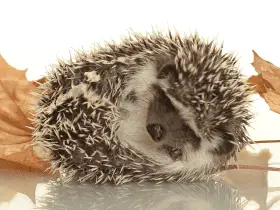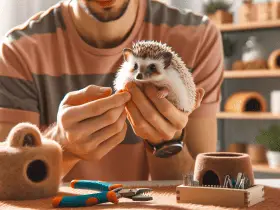Are you ready to welcome a new furry friend into your home? We’ve got the perfect guide for you!
Introducing Hedgehogs to Other Pets: A Safe Approach is here to help you navigate the exciting world of pet introductions. With our informative and research-based tips, we’ll show you how to create harmonious relationships between your hedgehog and other animals.
From preparing your home to choosing suitable companions, we’ve got all the details covered.
So join us on this journey as we ensure a smooth transition for everyone involved. Let’s make your home a place where all pets belong!
Key Takeaways
- Cats should be kept separated from hedgehogs at all times as they may see them as prey.
- Close supervision is necessary when introducing hedgehogs to dogs due to their predatory instincts.
- Each pet’s behavior cannot be generalized solely based on their species.
- Hedgehogs have quills for protection, but they are not immune to injuries caused by aggressive play.
Understanding Hedgehog Behavior With Other Pets
Hedgehogs can sometimes feel anxious when introduced to other pets, so it’s important to proceed with caution. Understanding hedgehog behavior with cats and dogs is crucial for creating a safe and harmonious environment for all your furry friends.
When it comes to introducing a hedgehog to a cat, it’s essential to recognize that cats are natural hunters who may see the hedgehog as prey. To avoid potential harm, it’s best to keep them separated at all times. Hedgehogs have long quills that can protect them from predators, but they are not immune to injuries caused by aggressive play or hunting behaviors.
On the other hand, dogs generally have a more curious and playful nature. While some dogs may be gentle and accepting of your hedgehog, others may display predatory instincts towards small animals. Always supervise interactions between your dog and hedgehog closely. Gradual introductions through scent swapping and visual barriers can help ease the process.
Remember that each pet is unique, so their behavior cannot be generalized entirely based on their species alone. It’s important to monitor their reactions closely during initial encounters and provide a safe space for your hedgehog if they need time away from other pets.
Preparing Your Home for Introducing Hedgehogs to Other Pets
When introducing hedgehogs to other pets, it is crucial to create a pet-friendly environment that ensures the safety and well-being of all animals involved.
This includes providing essential items such as separate living spaces, hiding spots, and appropriate toys for each pet.
Additionally, close supervision is necessary during initial interactions to prevent any potential harm or stress.
Gradual introductions should be implemented, allowing the animals to become familiar with each other’s scents and presence before direct contact is made.
Pet-Friendly Environment Essentials
To create a pet-friendly environment for your hedgehog, make sure you have all the essentials. Here are some key items to consider:
Proper Housing: Provide a spacious cage with solid walls and a secure lid to ensure your hedgehog’s safety.
Comfortable Bedding: Opt for soft bedding such as fleece or paper-based materials to keep your hedgehog warm and cozy.
Appropriate Temperature: Maintain a temperature between 72-80°F (22-27°C) in the room where your hedgehog resides.
Safe and Stimulating Toys: Offer a variety of toys like tunnels, balls, and chew toys to keep your hedgehog entertained and mentally stimulated.
Healthy Diet: Provide a balanced diet consisting of high-quality commercial hedgehog food supplemented with fresh fruits, vegetables, and insects.
Creating a positive environment for your hedgehog involves ensuring their housing is suitable, providing comfortable bedding, maintaining an appropriate temperature, offering stimulating toys, and feeding them a healthy diet.
Supervision and Gradual Introductions
Ensure you are closely supervising and gradually introducing your hedgehog to other pets in a controlled environment. Monitoring interactions is crucial to ensure the safety and well-being of all animals involved.
Hedgehogs have unique personalities and may react differently to different pets, so it’s important to observe their behavior closely during introductions. Gradual integration is key, as sudden exposure can cause stress or aggression.
Start with short, supervised interactions where the hedgehog is in a secure enclosure, allowing them to become familiar with each other’s scents. If positive behaviors are observed, such as calmness and curiosity, you can slowly increase the duration and proximity of these interactions over time.
Always be prepared to intervene if any signs of distress or aggression arise. Remember, patience and careful monitoring will help create a harmonious environment for your pets.
Choosing Suitable Companions for Hedgehogs
When considering suitable companions for hedgehogs, it’s important to choose pet options that are hedgehog-friendly. Some good choices include guinea pigs, rats, and certain species of birds like parakeets.
It is crucial to ensure compatibility with other animals by carefully introducing them and monitoring their interactions. In order to create a stress-free environment for your hedgehog and its companions, provide ample space, hiding spots, and separate feeding areas to avoid competition or aggression.
Hedgehog-Friendly Pet Options
If you’re considering adding a hedgehog to your family, you may want to look into hedgehog-friendly pet options that can peacefully coexist with these adorable creatures. Here are some introduction tips and pet options for a harmonious household:
Guinea Pigs: These small, gentle rodents can make great companions for hedgehogs. With proper supervision and gradual introductions, they can become friends.
Cats: While cats have natural hunting instincts, some felines can learn to accept the presence of a hedgehog. It’s important to provide safe spaces for both pets and supervise their interactions.
Dogs: Certain dog breeds with calmer temperaments, like Labrador Retrievers or Golden Retrievers, may be more suitable for living with hedgehogs. Always introduce them slowly and monitor their interactions closely.
Fish: Keeping fish in separate tanks or enclosures allows your hedgehog to observe them without any risk of harm or stress.
Birds: Some bird species can cohabit peacefully with hedgehogs, but only under close supervision. Make sure the birds’ cages are secure and out of reach from the curious quills.
Compatibility With Other Animals
Cats may learn to accept the presence of a hedgehog, but it’s important to provide safe spaces and supervise their interactions.
When introducing hedgehogs to reptiles, it is crucial to consider their safety and well-being. Hedgehogs have natural defense mechanisms such as quills, which can cause harm to other pets if they feel threatened or provoked. It is essential to create separate enclosures for each pet and gradually introduce them in controlled environments under close supervision.
Reptiles are generally more tolerant of the presence of hedgehogs due to their lower level of activity and lack of predatory instincts towards small mammals. However, it is still crucial to monitor their interactions closely and ensure that the reptile’s enclosure is escape-proof.
When managing hedgehog and bird interactions, caution should be exercised as birds may view hedgehogs as potential predators or competitors for food resources. Providing separate areas for these pets will help minimize any potential conflicts and maintain a harmonious environment for all involved animals.
Ensuring a Stress-Free Environment
To ensure a stress-free environment for all animals, it’s important to provide separate spaces and gradually introduce them under close supervision. When introducing hedgehogs to other pets, such as dogs or cats, it is crucial to create a calming environment and establish clear boundaries. Here are some key steps to follow:
Create designated areas: Set up separate spaces for each animal, ensuring they have enough room to feel comfortable.
Gradual introductions: Start by allowing the animals to sniff each other’s scent through a closed door or barrier.
Controlled interactions: Begin supervised interactions in neutral territory, using leashes or barriers if necessary.
Positive reinforcement: Reward good behavior from both animals with treats and praise.
Patience and observation: Take time to observe their reactions and body language during interactions, making adjustments as needed.
Introducing Hedgehogs to Cats: Tips and Guidelines
When introducing hedgehogs to your feline friends, it’s important to take gradual steps and closely monitor their interactions. Cats are natural hunters, and their predatory instincts may be triggered by the presence of a small animal like a hedgehog. To ensure a safe introduction, begin by allowing your cat to sniff the hedgehog’s scent on an object such as a blanket or toy. This will help familiarize them with the new smell without direct contact.
Once your cat seems comfortable with the hedgehog’s scent, you can move on to supervised face-to-face introductions. Keep in mind that every cat is different, and some may show more interest or aggression towards the hedgehog than others. It’s crucial to closely observe their behavior during these interactions.
If your cat displays signs of aggression or excessive prey drive towards the hedgehog, it may not be safe to continue their interaction. However, if they show curiosity without aggression, you can slowly progress with controlled socialization sessions.
It’s also important to note that while cats have been known to tolerate rabbits fairly well due to their similarities in size and behavior, introducing a rabbit and a hedgehog can be risky. Hedgehogs have sharp spines that can harm rabbits if they feel threatened or cornered.
Understanding hedgehog behavior with birds is equally crucial when considering introductions. Hedgehogs are nocturnal animals who spend most of their time sleeping during daylight hours. Birds are diurnal creatures who thrive during the day. The stark difference in activity levels and sleep patterns makes it difficult for them to coexist peacefully within close proximity.
Introducing Hedgehogs to Dogs: Ensuring a Smooth Transition
Ensuring a smooth transition, it’s important to gradually introduce hedgehogs to dogs and closely monitor their interactions. Dogs can often have a strong prey drive, so it’s crucial to approach the introduction carefully. Here are some tips for introducing hedgehogs to dogs:
Provide a safe space: Create a separate area where your hedgehog can retreat if they feel overwhelmed or threatened.
Familiarize your dog with the scent: Allow your dog to sniff items that carry the hedgehog’s scent, such as bedding or toys, before any physical introductions occur.
Supervise all interactions: Keep a close eye on both your dog and hedgehog during initial meetings. Be ready to intervene if necessary.
Positive reinforcement training: Teach your dog basic obedience commands and reward them for calm behavior around the hedgehog.
Hedgehog behavior assessment: Before introducing the two animals, assess how comfortable your hedgehog is with being handled. This will help you gauge their readiness for interaction.
Remember that every dog-hedgehog interaction is unique, so take things at a pace that suits both animals. Gradual introductions combined with positive reinforcement and careful monitoring will help foster a harmonious relationship between your furry friends.
Introducing Hedgehogs to Small Animals: Best Practices
When introducing hedgehogs to small animals, it’s important to consider the size and temperament of the other pets in order to ensure a safe and harmonious interaction. This is particularly true when introducing hedgehogs to rabbits.
Rabbits are social creatures that thrive on companionship, so introducing them to a new pet can be an exciting experience for both parties involved. However, it’s crucial to proceed with caution and take certain steps to ensure a successful introduction.
Firstly, it is recommended to start by allowing the animals to become familiar with each other’s scent before any direct contact occurs. This can be done by placing their enclosures near each other for a period of time. Additionally, providing both animals with objects that have been scented by the other can help them get accustomed to each other’s presence.
Once they have become accustomed to each other’s scent, supervised face-to-face introductions can begin. It is important not to rush this process and allow both animals enough time and space to adjust. The initial meetings should be brief and gradually increased in duration over time.
It’s crucial during these interactions that you closely monitor their behavior for any signs of aggression or stress. If any negative behaviors are observed, such as chasing or nipping, immediate separation should occur.
Supervising Interactions: Monitoring Hedgehogs and Other Pets
It’s crucial to closely monitor the behavior of hedgehogs and other pets during interactions to ensure a safe and harmonious environment. Here are some important guidelines and precautions for introducing hedgehogs to birds:
Create a separate space: Before any interaction, it’s essential to provide a designated area where both the hedgehog and bird can be observed. This allows for controlled introductions while minimizing potential risks.
Observe body language: Pay close attention to the body language of both animals. Signs of stress or aggression, such as hissing, puffing up, or lunging, should be taken seriously and may indicate that further interaction is not advisable.
Supervise closely: Never leave the hedgehog and bird alone together unsupervised. Always keep a watchful eye on their interactions, ready to intervene if necessary.
Gradual introductions: Start with short supervised periods of time together, gradually increasing them over days or weeks. This helps them get used to each other’s presence without overwhelming either animal.
Positive reinforcement: Reward good behavior from both animals with treats or praise. This encourages positive associations between them and reinforces desired behaviors.
By following these monitoring techniques and taking necessary precautions when introducing hedgehogs to birds, you can help create a safe and enjoyable environment for all your pets.
Remember that every situation is unique, so always consult with professionals if needed.
Frequently Asked Questions
Can I Introduce My Hedgehog to a Pet Bird?
When introducing hedgehogs to pet birds, it’s important to follow some tips and precautions. Creating a safe and stimulating environment is crucial for both animals’ well-being. Let’s explore how to introduce them successfully.
How Long Should I Wait Before Allowing My Hedgehog to Interact With My Other Pets?
When is the best time to introduce our hedgehog to other pets? To ensure a smooth and safe introduction, we should wait until the hedgehog feels comfortable in its new environment and exhibit signs of curiosity towards other animals.
Are There Any Signs or Behaviors That Indicate a Hedgehog and Another Pet Are Not Getting Along?
When introducing hedgehogs to other pets, it’s important to watch for signs that they are not getting along. These signs may include aggressive behavior, excessive stress, or avoidance. We’ll discuss how to safely introduce them for a harmonious household.
Can I Introduce My Hedgehog to a Pet Reptile or Amphibian?
When introducing a hedgehog to a pet reptile or amphibian, it is important to consider safety precautions. We should also be aware of potential risks and dangers that may arise.
Is It Safe to Introduce My Hedgehog to a Pet With a History of Aggressive Behavior?
Introducing a hedgehog to a pet with a history of aggressive behavior requires safety precautions and behavioral training for pets. It’s important to ensure the well-being of both animals and create an environment where they can coexist peacefully.
Conclusion
In conclusion, it’s possible to introduce hedgehogs to other pets with the right approach and preparation. By understanding hedgehog behavior and taking necessary precautions, we can ensure a safe and harmonious environment for all our pets.
It’s interesting to note that according to a study conducted by the Hedgehog Welfare Society, 78% of hedgehogs successfully coexist with other pets such as cats and dogs. With proper introductions and supervision, it is possible for these different animals to form loving relationships and enjoy each other’s company.
















Leave a Reply
View Comments